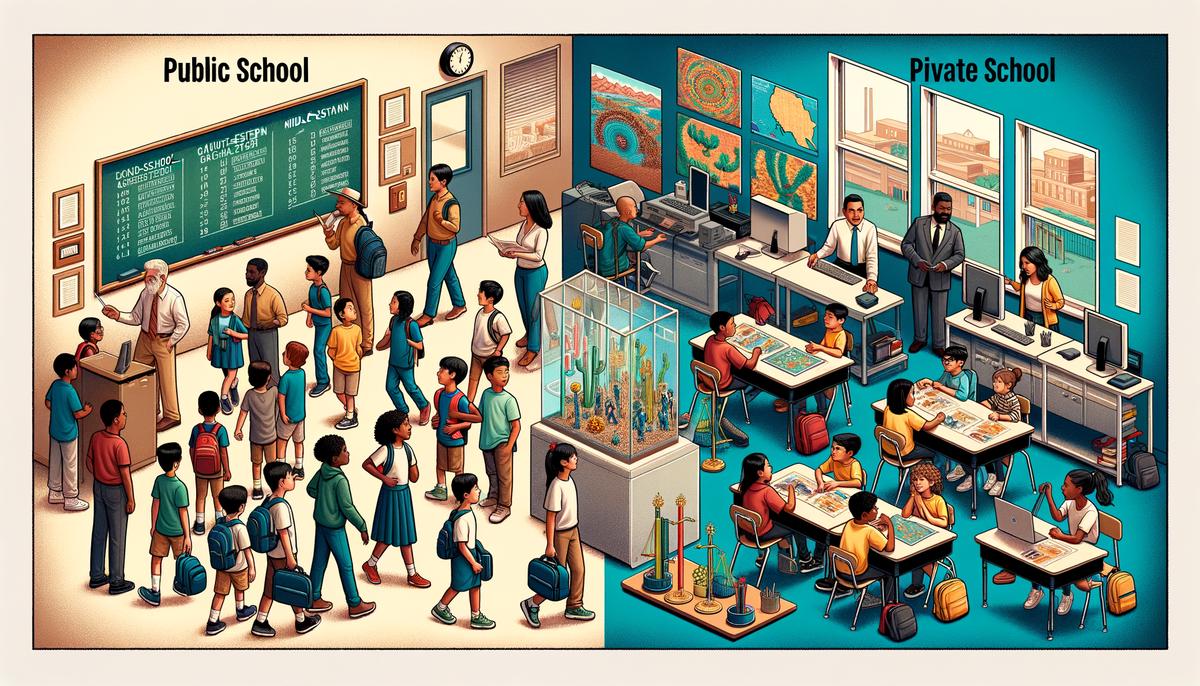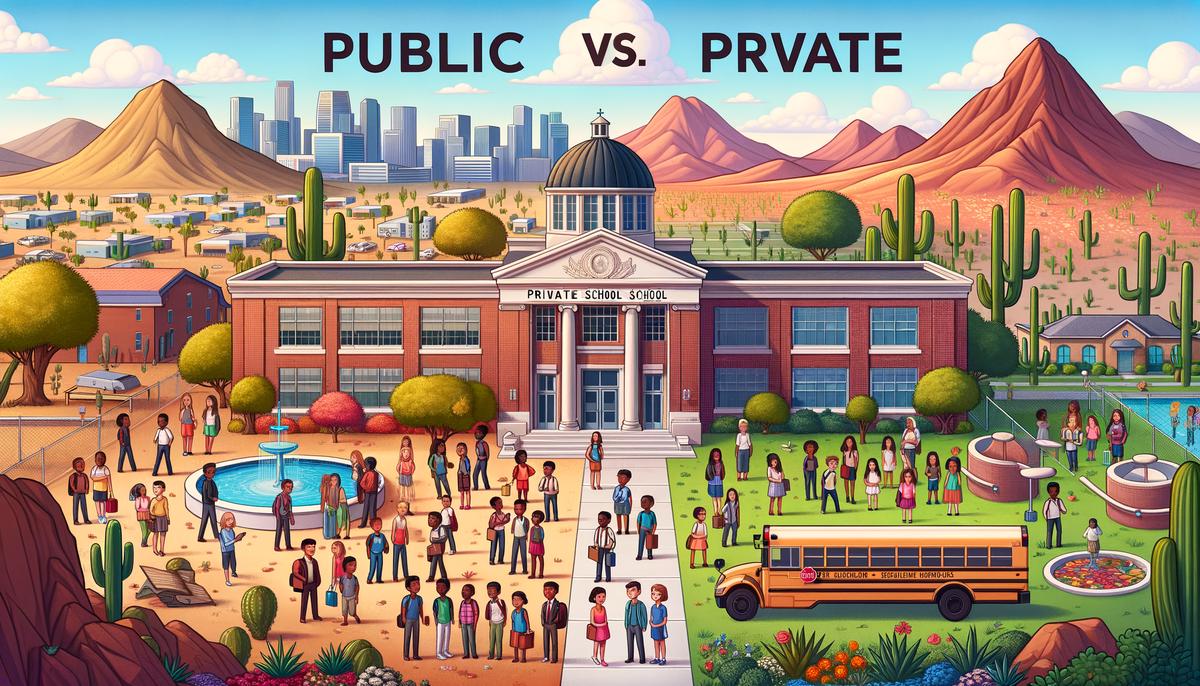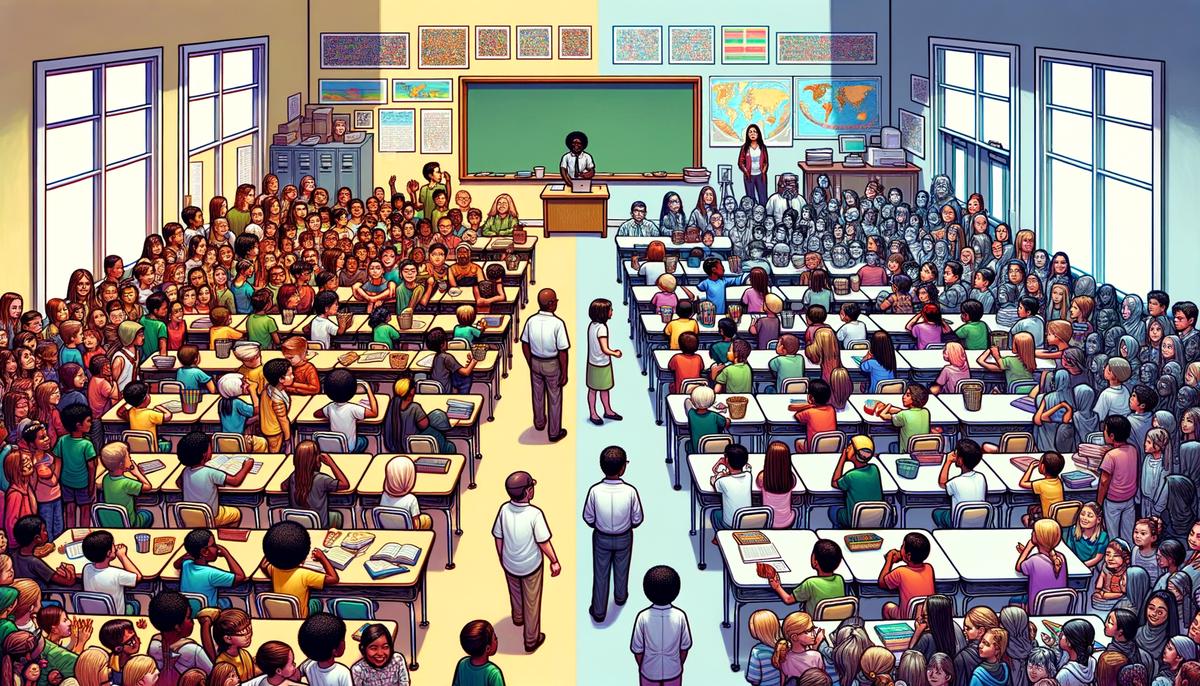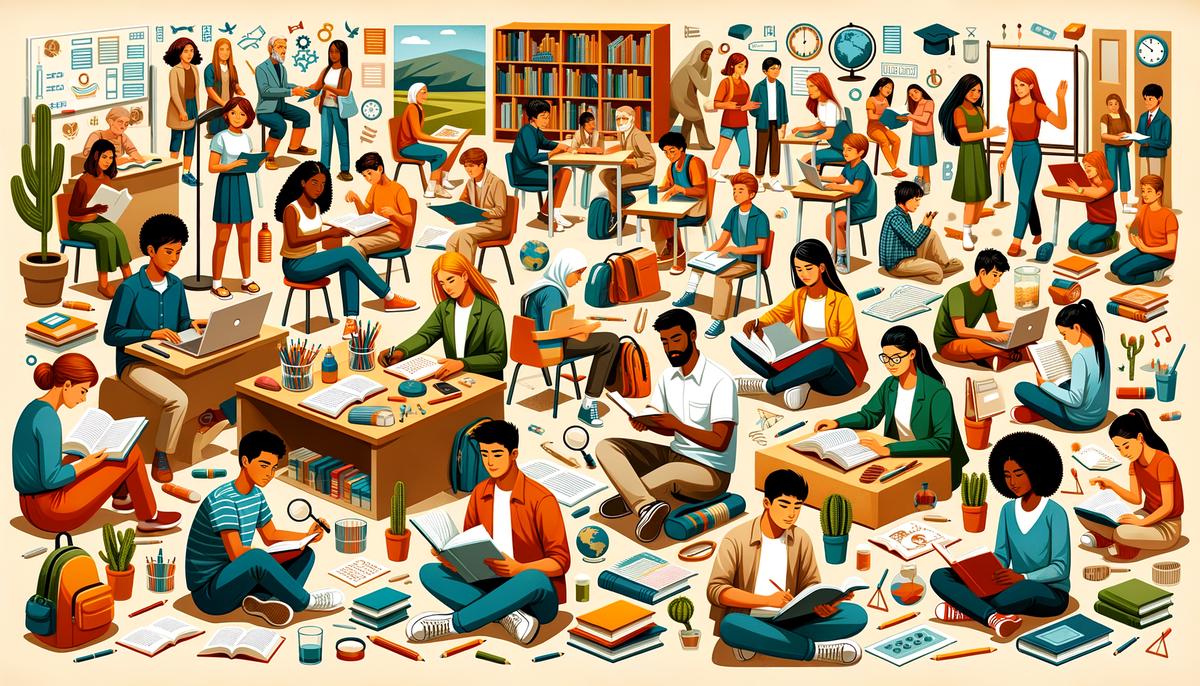Education, a cornerstone of society, presents a spectrum of experiences influenced by the type of institution one attends. The distinction between public and private schools in Arizona serves as a prime example, shedding light on how funding, resources, and educational philosophies shape the learning environment. This discussion aims to provide a comprehensive overview of these differences, offering insights into their implications for students, teachers, and the broader community.
Funding and Resources
Public schools in Arizona get their money mostly from state and local taxes. This funding system means how rich or poor an area is can seriously affect the quality of its schools. In wealthier areas, schools might have more money for things like new books or computers. Poorer areas might not have as much, making it harder for students to get the same quality of education.
Private schools, on the other hand, rely mostly on tuition, donations, and sometimes grants. This can lead to a wider range of resources available to their students. Because they’re not limited by the same rules that public schools are, private schools can often spend more on each student. This might include more up-to-date technology, smaller class sizes, and more after-school programs.
One big difference is how these schools can use their money. Public schools have to follow strict rules and often can’t spend on things outside of those rules. Private schools have more freedom to invest in special programs or facilities they think will benefit their students.
Donations also play a big part in how these schools operate. Private schools often have alumni or other supporters who donate money. This can lead to better facilities or more scholarships for students who need them. Public schools don’t usually get this kind of support, which can widen the gap between what different schools can offer.
However, it’s not all bad news for public schools. In Arizona, programs like tax credit donations allow individuals and businesses to donate directly to public schools. This can help bridge the gap, letting public schools fund extracurricular activities, clubs, or special programs they wouldn’t otherwise afford.
In terms of technology, private schools often have more resources to provide students with the latest gadgets and learning tools. Public schools might have fewer technological resources due to their limited budgets, impacting how students learn in today’s digital world.
Textbooks in private schools are frequently updated and in good condition, reflecting their ability to allocate funds for such materials as needed. Public schools, facing budget constraints, might struggle to provide the newest editions of textbooks, sometimes relying on older or used books.
Extracurricular activities in private schools can include a wide range of options, from sports to arts and beyond, supported by the school’s funds and donations. Public schools might offer fewer extracurricular options due to budget limitations, potentially impacting students’ ability to explore varied interests.
Despite these differences, both public and private schools in Arizona are working towards providing the best education possible. Each has its methods and resources, shaping unique educational experiences for their students.

Curriculum and Academic Freedom
In Arizona, public schools adhere to a curriculum set by state education standards, ensuring consistency across the board. The Arizona Department of Education oversees these standards, which cover core subjects like mathematics, science, English language arts, and social studies. Public school teachers have a roadmap but must navigate within these predetermined paths, limiting flexibility to deviate based on student interests or to adopt innovative teaching methods not covered by the standard curriculum.
Private schools, on the other hand, enjoy a greater latitude in curriculum development. They aren’t bound by state standards and thus have the freedom to design courses that reflect their educational philosophy. This freedom allows them to intertwine various teaching methods, integrate cross-disciplinary subjects, and cater to students’ unique learning styles more robustly. For instance, a private school with a focus on STEM could offer advanced robotics classes not typically found in public school curricula, or a school with a classical education model could prioritize Latin, logic, and rhetoric.
Academic freedom extends beyond curriculum content; it also reflects in teaching methods. Public school educators often face pressures related to standardized testing. Their performance and that of their students are frequently evaluated based on test scores, guiding much of the instruction towards test preparation. This focus can sometimes restrict teachers’ ability to employ creative or experimental techniques that foster deeper intellectual exploration, as they must ensure all required standards are covered for testing purposes.
Private schools are not subject to the same high-stakes testing requirements as public schools. Without the looming pressure of standardized tests dictating teaching priorities, private educators can spend more time on exploratory learning, critical thinking, and skill development. This academic flexibility encourages a culture where teaching can be tailored to student interests and real-world applications, enhancing engagement and potentially leading to a deeper understanding of the material.
The variability in standards and testing regimes can lead to disparities in what students learn at different types of schools and their preparedness for future academic or career paths. For instance, those from a test-focused public school environment might excel in structured settings but could lack experience in inquiry-based learning scenarios that private school students might encounter regularly.
Teacher autonomy differs as well. In public schools, teachers often follow a tight curriculum aligned with state standards and district policies, which might limit their ability to introduce subjects they’re passionate about or that might greatly benefit their students. Private school teachers usually have more freedom to design their syllabus, choose their teaching materials, and decide how they want to approach a subject, allowing them to make dynamic adjustments tailored to their students’ engagement levels and understanding.
In conclusion, the differences in curriculum and academic freedom between public and private schools in Arizona mirror broader debates about educational consistency versus innovation, mandated standards versus individualized learning experiences, and preparation for testing versus holistic education. These distinctions shape not only the immediate learning environment but also impact students’ long-term educational trajectories and their views on learning itself.

Class Size and Teacher Qualifications
When it comes to class sizes, public schools in Arizona generally see a higher student-to-teacher ratio compared to private schools. This difference directly impacts the level of individual attention a teacher can provide to each student. In public schools, a single teacher might find themselves navigating the educational needs of 30 or more students in a classroom, diluting the possible personalized guidance they can offer. Private schools, on the other hand, boast smaller class sizes, sometimes with ratios as intimate as 15 students per teacher, allowing for a more tailored teaching approach that can adapt to the unique learning styles of each student.
Teacher qualifications present another point of contrast between public and private schools. Public school teachers in Arizona are required to hold a bachelor’s degree, complete an approved teacher education program, and pass a state certification exam. They’re also subject to background checks before setting foot in the classroom. For ongoing professional development, Arizona mandates that public school teachers participate in continuous learning to renew their certification periodically. These requirements ensure that public school educators are both well-prepared initially and remain informed about modern teaching strategies and subject-specific advancements.
Contrastingly, private schools in Arizona carry the liberty to set their own hiring standards for teachers. While many private school teachers do hold advanced degrees and certifications, it’s not a universally applied standard. Some private institutions may prioritize practical teaching experience or a strong alignment with the school’s specific educational philosophy over formal qualifications. This flexibility can bring a wide variety of teaching experiences and backgrounds into the private school classroom, potentially enriching the learning environment but also causing variability in teacher qualification levels across institutions.
Furthermore, the impact of these factors on the learning environment is profound. In public schools, where class sizes are larger and the teacher’s attention is divided among more students, the environment can be challenging for both teaching and learning. Teachers may struggle to cater to individual needs, and students may find it harder to engage. In contrast, private schools’ smaller classes facilitate a more interactive and participatory learning experience, where teachers can readily adjust their methods to suit their students better.
Teacher qualifications and class sizes are not just administrative statistics; they play critical roles in shaping the educational journey of students. The expertise brought by qualified teachers, coupled with the environment fostered by smaller class sizes, significantly boosts the quality of education a student receives. This directly influences not only academic achievements but also a student’s confidence, motivation, and passion for learning.
While both public and private schools aim to provide quality education, the factors of class size and teacher qualifications set them apart in creating distinct educational experiences. The intimate class settings and potentially diverse qualifications of private school teachers offer a contrast to the structured, regulation-driven environment of public schools. Each setting offers its unique advantages, shaping students in different yet significant ways.

Student Diversity and Inclusivity
Diving further into the kaleidoscope of student diversity and inclusivity in Arizona’s schools, it’s fascinating to unravel how both public and private institutions fold these elements into their tapestry. Starting with public schools, these institutions mirror the community’s demographic makeup. Hence, they often boast a more heterogeneous population. The melting pot of races, ethnicities, and socioeconomic backgrounds found in public schools provides a rich, real-world social environment for students.
Inclusivity policies in public schools typically follow federal and state guidelines, ensuring accommodations for students with disabilities, language translation services for English Language Learners (ELLs), and programs aimed at closing the achievement gap for students from low-income families. This commitment is a cornerstone in fostering an environment where every student, regardless of their background, receives the education they deserve.
Switching lenses to private schools in Arizona reveals a different picture. The selection process in these institutions, which often includes admissions tests and interviews, combined with tuition fees, may limit the breadth of diversity found in their student bodies. Particularly, racial and socioeconomic diversity in private schools can appear less pronounced when compared to their public counterparts. Yet, it’s notable that many private schools strive to diversify their student population through scholarships and inclusive admission policies.
When it comes to inclusivity, some private schools stand out with specialized programs supporting students with learning differences and disabilities. These schools often boast tailored learning plans, smaller class sizes, and specialized staff, providing an environment where diverse learning needs can be met more effectively than in overcrowded public schools. However, it’s essential to highlight that the level of inclusivity can vary significantly from one private institution to another, dependent largely on the school’s philosophy, resources, and community involvement.
Both school types make concerted efforts to nurture an inclusive atmosphere. For example, public schools in Arizona might incorporate diversity and inclusion training in their curriculum, aiming to educate students on the value of understanding and respecting different cultures. On the other side, private schools might host international days or culture weeks, celebrating the myriad backgrounds of their student body, albeit smaller in diversity.
Inclusivity in education extends beyond just racial and socioeconomic lines; it also envelops ideologies, learning abilities, and even gender identity. In this realm, some argue that private schools might have greater liberty to adopt progressive policies due to their freedom from certain state mandates constraining public schools. Meanwhile, public schools benefit from specific federal and state funding aimed at supporting inclusivity and diversity programs.
The interplay between student body diversity and inclusivity in public versus private schools in Arizona paints a complex yet riveting picture. Each type of school offers unique advantages and faces distinct challenges in serving a diverse student population. As debates on education continue to evolve, the focus remains on how best to serve all students, providing them with the educational experiences and opportunities they need to thrive in an increasingly diverse world.

Outcomes and Performance
When it comes to academic outcomes, both public and private schools in Arizona showcase distinct results that reflect their diverse approaches and resources. Standardized test scores, a widely used metric, often reveal higher averages among private school students. This trend can be attributed to the tailored instructional methods and the often more rigorous academic environments found in these institutions.
For college admissions, students from private schools in Arizona tend to have a higher rate of acceptance into prestigious universities. This advantage may stem from the extensive counseling resources and extracurricular opportunities that are more readily available in private institutions. These elements not only enhance a student’s application but also develop essential skills for future academic and career success.
Beyond academics, student well-being and satisfaction surveys frequently indicate higher ratings among private school attendees. This could be due to smaller class sizes which allow for a more personalized learning experience and stronger relationships between students and faculty. The emphasis on holistic education, including mental health support and character development programs, plays a key role in this difference as well.
In terms of extracurricular achievements, private schools often outperform public schools, courtesy of their greater financial resources and facilities. From sports to the arts, private schools offer a plethora of activities that are less accessible in the public system due to budget constraints. These opportunities not only enrich the student experience but also encourage engagement, teamwork, and leadership skills.
Despite these differences, it’s important to acknowledge that many public schools in Arizona are making strides in improving performance metrics through innovative programs and community partnerships. Initiatives aiming to enhance STEM education, reading programs, and access to mental health resources are gradually narrowing the gap in academic outcomes and student satisfaction.
The comparison of outcomes between public and private schools in Arizona indicates vast disparities shaped by factors such as funding, resources, and philosophical approaches to education. While private schools often lead in standardized test scores and college admissions, public schools offer a valuable education to a diverse student body, striving for inclusivity and equity. Both systems have their strengths and challenges, with each playing a crucial role in the educational landscape of Arizona.

In conclusion, the contrast between public and private schools in Arizona underscores a broader conversation about educational equity and quality. The most critical takeaway is the need for a balanced approach that leverages the strengths of both systems to support all students’ learning journeys. By acknowledging and addressing the disparities, we can work towards an educational landscape that fosters excellence, inclusivity, and opportunity for every student.
Writio: AI content writer for websites. This article was written by Writio.
Leave a Reply